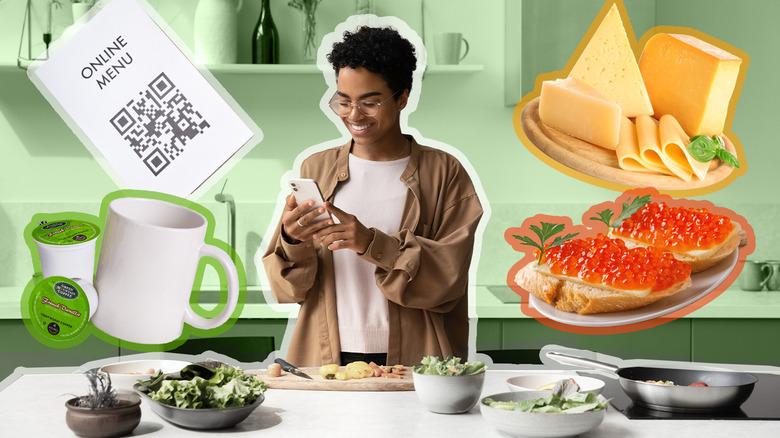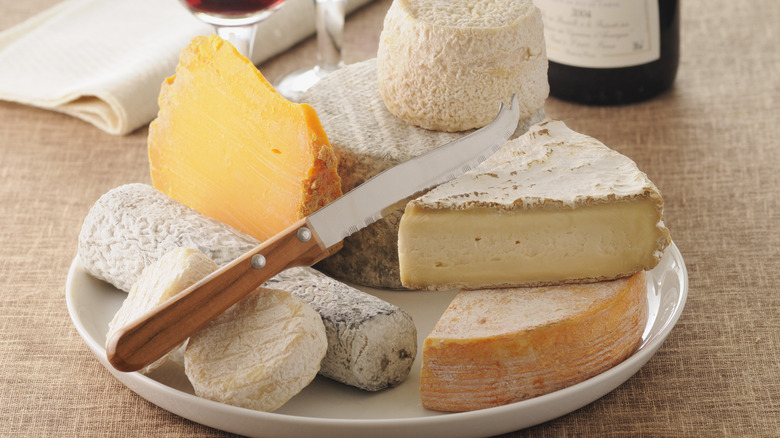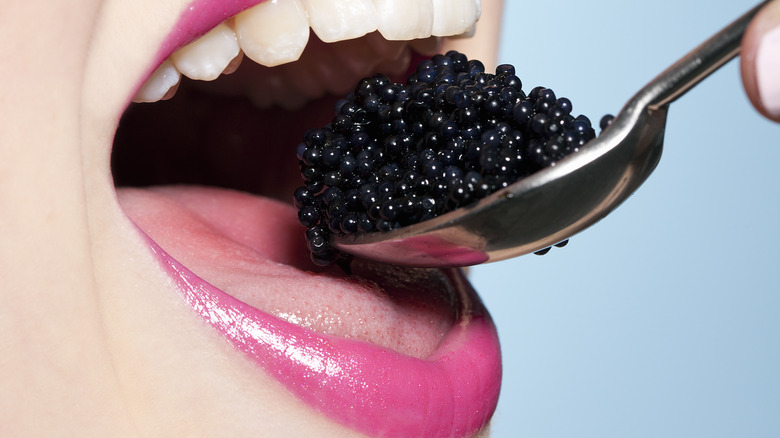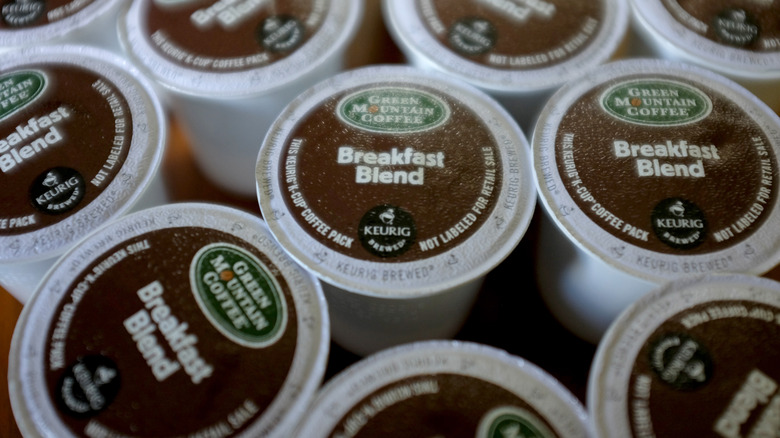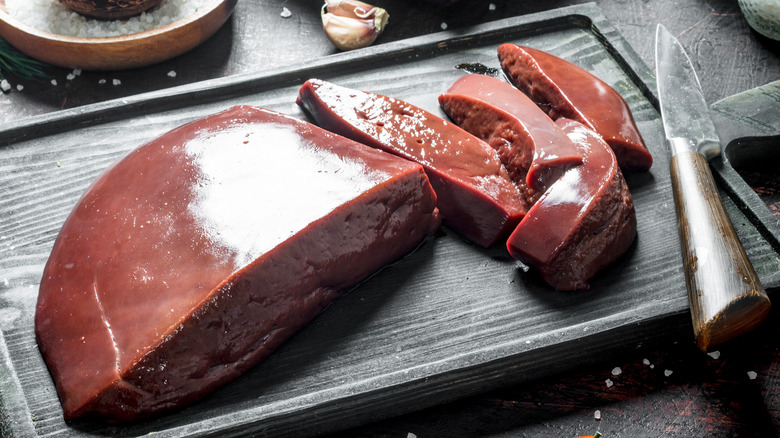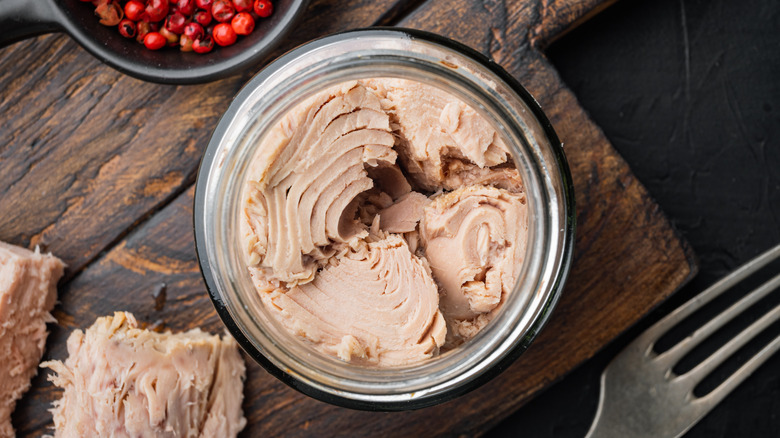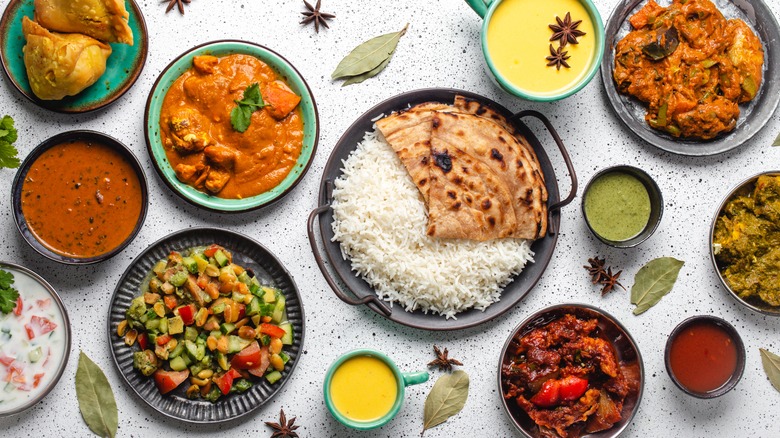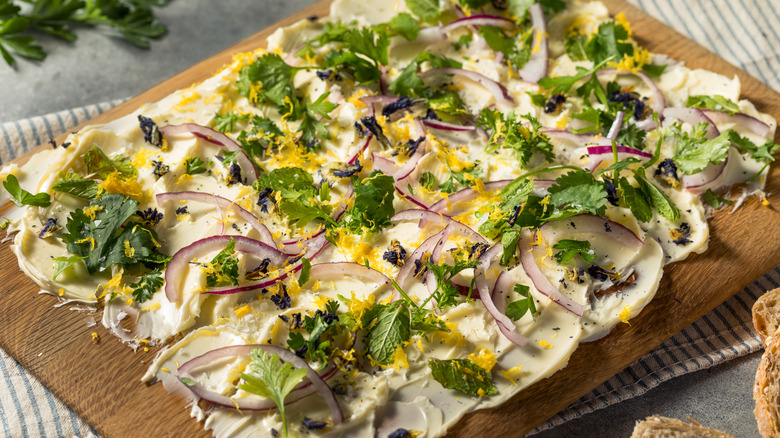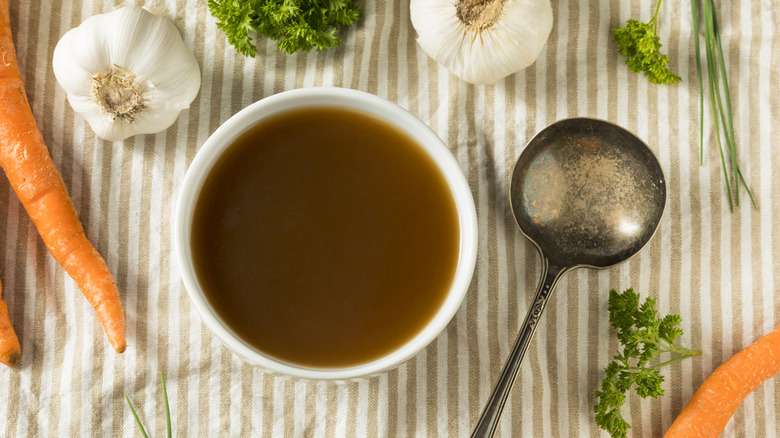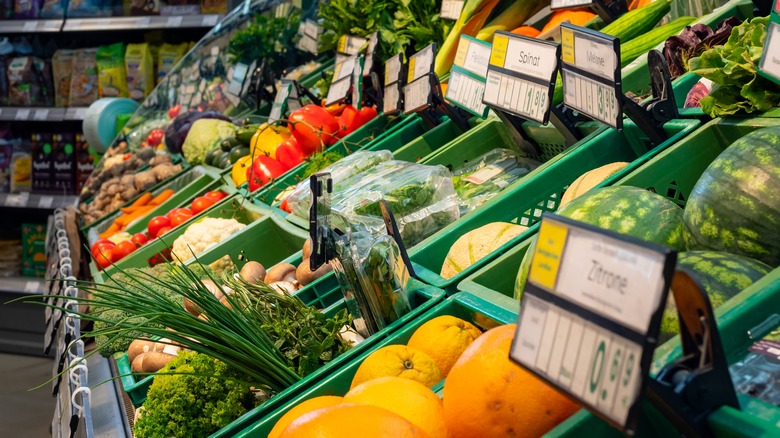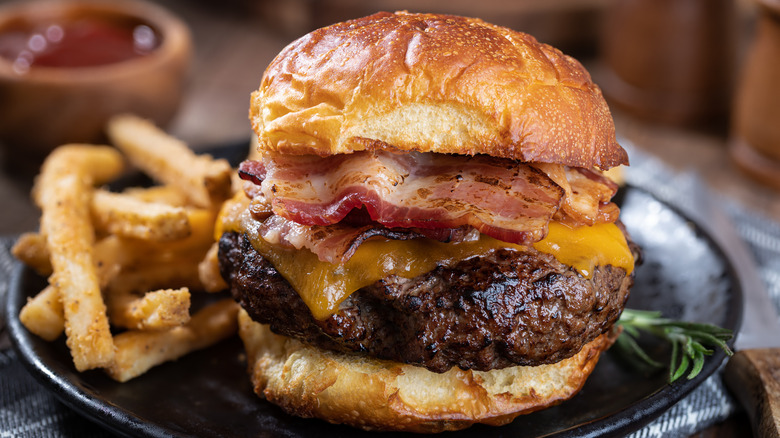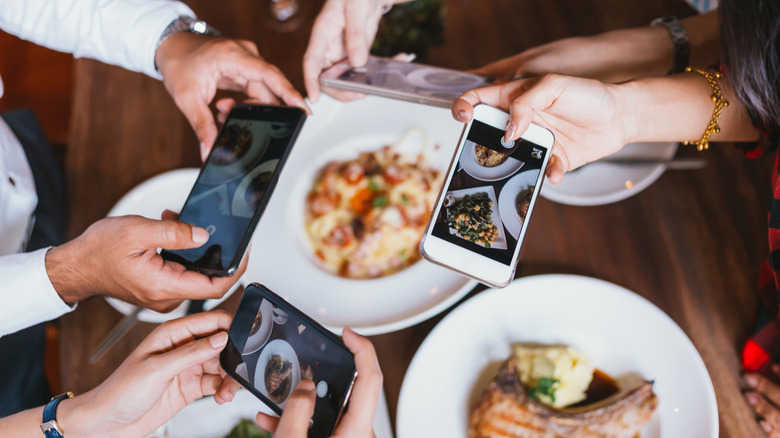15 Food Trends To Leave Behind In 2023
Along with rocking white-wash denim jackets and permed hair, trends tend to come and go. Just about everything goes through cycles (*cough* gray wood flooring *cough*), including food. Sure, meals at the Olive Garden and Chuck E. Cheese are about the same today as they were a decade ago, but many other restaurants, influencers, and food personalities often lean heavily into the world of culinary trends. Some are great, but others need to die horrible, excruciating deaths (figuratively, of course).
Good recipes will last a lifetime. They will be passed down from one generation to the next. Some foods, no matter what is happening in the world, will always be timeless. Trendy, on the other hand, often crashes and burns just as quickly as it came. And sometimes, this crash and burn can't come soon enough. Here are a few food trends we want to see banished in 2023, never to see daylight again.
1. Cooking on the counter
Proof that you can't eat at just anyone's home, if you haven't seen this trend, thank your lucky stars. It's picked up steam on platforms like Instagram and TikTok, so if you're not a regular on those platforms it's probably why you haven't seen it. Basically, people are preparing meals directly on their kitchen counters. They will dump pasta onto the granite, pour over sauce (some even light it on fire), toss in an assortment of cheeses, and who knows what else (we're pretty sure some people just blindly grab at anything in their cabinets and pour it onto the monstrosity) then mix it up and serve.
This is a trend that should have never started. The origins of this cooking "method" began as a tabletop nacho experience with corn chips and nacho toppings strewn over a table, and then devolved into all kinds of terrible ideas. In the words of Marge Simpson, "You're talking about a trough. We're not going to eat out of a trough." Plates will never go out of style. It's also why, if someone invites you over for dinner, you should check out their social media presence.
2. Cheese boards
There was an episode of "The Office" where Andy Bernard prepared a "cheese spread" with cheese fish crackers, old cheddar that had formed an odd-tasting rind, and spray-can cheese. It was funny until people started to take this literally. It's as if people sat around during the pandemic, watching "The Office", and decided that yes, it would be a good idea to use bland, basic cheese on the spread when inviting friends and family over.
We're not saying that every single cheese board needs to be banished to the nether regions of the culinary world. What we are saying is the vast, vast, vast majority should, because the cheese used is boring and inferior. The entire purpose of a cheese board is to open you up to new flavors and interesting cheeses that you likely haven't experienced before — unique cheese from Denmark or Singapore, dairy offerings from South Africa or Mongolia. The cheese options available are nearly limitless, so stop with the cubes of sharp cheddar and pepper jack. If we wanted that we'd just grab the free samples at Costco. If you're going to build a cheese board, be original.
3. Restaurant service charges
Running a restaurant is difficult work. The margins are often razor-thin. Unless establishments can sell a copious amount of booze, trying to make ends meet inside a restaurant is difficult. We understand needing to raise prices on some menu items. After all, inflation has hit the food industry, causing the surging prices of all kinds of goods. So, when lettuce, eggs, bread, and just about everything else increases, it makes sense to see boosting menu costs.
Do you know what doesn't sense? All the ridiculous restaurant service charges. Make a reservation and show up on time? Have fun waiting. Show up 15 minutes late? Have fun paying a fee. Service charges on your entire bill are not unusual.
When you see a service charge on your bill, what do you assume? That the server is receiving that, right? That's what we thought. And we were dead wrong. According to Vox, it depends on the state: In New York, if a service fee is listed, it has to go to the staff, but in Florida and California, the charge can be used for anything, and often, it goes back into the owner's pocket. We want transparency with our restaurant bills.
4. Caviar on everything
Do you have that one friend that makes a food discovery late in life, but once they do, they start putting it on everything? Well, the food world is like that. Some influencer or chef stumbles upon an ingredient, and then suddenly everyone wants to copy them. Before long, things get out of control. Avocado had that moment not long ago (we're still kind of in that phase). Truffle oil did as well. For a time cilantro was popping up on everything, to the delight of some and the frustration of others. And now, we're living in a world where caviar is being slathered on everything. We have one question. Why?
Caviar is fine. It's a salty topping made up of fish eggs. Growing up we might see it served at the rich kid's family holiday party, where adults would top it off onto crackers. But now, it's being used literally on everything. In some instances, it seems like it is being used in replace of salt.
People are struggling with grocery bills, and yet restaurants want to top meals off with caviar, adding an unnecessary surcharge to the bill? We're just waiting for Chipotle to start offering caviar, just so they can remind us that "caviar is extra." We're not trying to cancel caviar, but as a topping on everything? It needs to end.
5. Keurig coffee pods
Yes, it's convenient. You wake up, slap a pod into the specialty maker, make sure there's water, and that's it. In terms of making coffee, it doesn't get any simpler than that (at least when you make it yourself). You're also paying a premium price for coffee from concentrate. Maybe you're using a Keurig coffee pod more for convenience over the actual taste. Because if you want the best-tasting cup of coffee, there are far better options available (even if there are some additional steps involved).
Well, here's the problem with coffee pods, regardless of the brand — and it's a big problem. If you have a single pod of coffee every day that is, at least 365 added pods of plastic ending up in landfills, with some ending up in the ocean. That's a ton of plastic. Sure, there are some reusable coffee pods out there, but this entire segment of the coffee industry is based on the consumption of plastics.
Besides, if you want true convenience, you can opt for a smart coffee maker, which allows you to literally tell Google or Alexa to make you a cup of coffee while you're still in bed. All without any added plastic.
6. Organ meat
The Liver King had himself a moment in 2022. He exploded on social media, and eventually traditional media, as he proclaimed his incredible physique came from eating mostly organ meat. Of course, he eventually was outed as someone who consumed steroids. However, beyond the rise and quick fall of the Liver King, organ meat in general is not very good for the human diet because of the incredibly high cholesterol and saturated fats. Just how much cholesterol? So, 3 ounces of pork brain contains 2,169 milligrams of cholesterol. It is recommended that you don't eat any more than 300 milligrams per day. In other words, 3 ounces of pork brain has over a week's worth of cholesterol.
Top to bottom, organ meat just isn't a great option. If you want to work out and pack on muscle there are far better ways to up your protein intake without sending your cholesterol levels into the stratosphere.
7. Tinned fish
There's nothing wrong with a can of tuna; it makes a heck of a good tuna fish sandwich. And some cans of albacore sitting in olive oil can be divine. But, tinned fish is going mainstream: Canned fish tacos are popping up in restaurants, canned fish on pizza is returning (anchovies haven't been all that popular in the U.S. for a while, but it's coming), and restaurants are even starting to serve canned oyster stew. Yes, times are tough and establishments are looking for ways to increase profit margins. But, this is just one step away from heading off to the local Italian restaurant and being served a plate of SpaghettiOs.
Some canned foods, like the aforementioned canned tuna, can be healthy meal options, but some of the canned foods are jumping in price, which is terrible news for those nuclear fallout preppers out there. If you want to enjoy canned fish at home, by all means, enjoy. But, we put our foot down when it comes to going to a restaurant and paying top dollar for a seafood dish fresh out of a sardine tin.
8. Whitewashing ethnic foods
Culinary styles from all over the world tend to thrive in the United States. Yet, the problem of food appropriation is becoming more prevalent, thanks mostly to social media. Individuals have taken classic food offerings from other countries and cultures and introduced them to U.S. residents with "Americanized" names.
Content creators on video platforms like YouTube, TikTok, Instagram, and even on food blogs, are taking classic dishes and, with little to no alterations to the original offering, swapping out the name — after all, what is American food anyway? While it's not realistic for everyone to know the origins of every dish they see in a video, this responsibility of cultural awareness is on the content creators, professional chefs to have recipes vetted, and owners of culturally appropriative restaurants than on the consumers.
Just because someone spent a week in Los Cabos doesn't give them the right to make off with a menu item and then swap the name out. These foods often have a significant historical connection and meaning. Anyone can cook what they like, but they should at least refer to it by its actual name; we're looking at you, cooks who take pico de gallo and call it cowboy caviar.
9. Butter boards
Cheese boards, when done right, actually have a purpose. But, butter boards are just fully unnecessary. If you're not familiar with the concept, a butter board is, as the name suggests, a cutting board smeared with one, if not several, kinds of butter. People are then forced to sponge up the butter with bread, crackers, pita, or whatever else they're gifted to use.
Our question is how did this ever become a thing? Dips served in group settings have always been in a bowl, with a spoon, allowing you to dolly up as much as you want onto your plate. This way, you're not forced to hover around the table every time you want to dip. But, with butter boards, you're almost forced to circle the table like a starved vulture. It's almost as if the world was never shut down due to an easily contagious virus. We can do better.
10. Upcharging for bone broth
This is such a marketing gimmick, designed to overcharge customers who don't know any better. Bone broth is made to sound exotic, but here's the thing. It's just broth. Take the bones from that Costco rotisserie chicken you have, toss them in a pot of water, and boil it down. The only real difference between bone broth and chicken stock is bone broth is cooked longer, so just let that pot simmer. Boom, you just prepared yourself about $50 worth of "bone broth" from chicken bones you were going to toss into the trash.
At a time when money is tight for so many people, we don't think it's right for customers to be tricked into buying something that's a cheap product with an expensive name tag. We are all about trying to help you save some cash. That is why we want you to take two lessons from this slide: bone broth is essentially a marketing term, and you can make bone broth yourself easily.
11. Expensive everything
Probably the worst trend of all (at least in terms of the culinary world) is that everything is getting more expensive. Yes, inflation has something to do with that, and most economic experts assumed something like this might happen because of the COVID shutdown. However, much more has been at play over the last year. In 2022 a disease swept through California lettuce producers, which killed most of the crop, and leaving Yuma, Arizona to produce the majority of the country's lettuce for several months, according to ABC7. While Yuma does produce a fine crop-producing location, it can't make up for all of California. Tack on a bird flu that wiped out millions of chickens and the subsequent eggs they produced to jack up the price of anything chicken related.
Hopefully, the rest of 2023 sees some stabilizing, and the cost of foods decreasing. We can't forecast problems with crops or farms, so we're crossing our fingers with this one. But, either way, it's a food trend that needs to stop.
12. Restaurant QR menus
Don't you miss the days of walking into a restaurant and having a menu placed in front of you? There was something comforting about it. Especially when those menus were bound inside of fine-leather folders. But now? Now you have to whip out your phone, attempt to focus on a QR code taped onto the table, and try to squint through the small font on your screen. Phone dead? That's unfortunate. Have kids? Better pass the phone around. Phone not detecting the QR code? Probably time to update your mobile device.
It's annoying, especially when the restaurant adds a lead-generating pop-up, asking for your email address or contact info. We're just trying to order a chicken sandwich, not sign up for a monthly subscription service. QR codes made sense during the pandemic to reduce contact. Now, they are just a pain, and we hope (however unlikely) that these QR menus go the way of the dodo.
13. $20-plus burgers
If you've stopped by a restaurant lately, you likely have noticed the increasing price point on burgers and fries. Sure, the base price of beef, buns, and vegetables have increased some over the last year, but not to the point where burgers can justifiably cost upwards of $20. Once upon a time, taking a family out for burgers and fries at a restaurant used to be an affordable option. Now, if you're a family of four, you're potentially dropping a hundred bucks at a sit-down burger joint. Might as well use that on an upgraded at-home grill.
It's a 2022 trend that probably won't stop in 2023. One of the problems is restaurants are tacking on so many unnecessary ingredients onto burgers. According to culinary legend Anthony Bourdain tells Cool Material, the perfect burger is a quality patty of beef, easily melted cheese, a squishy bun, and maybe a hit of ketchup and mustard. Everything else is just making the burger harder to eat, messier, and more expensive.
14. Bourbon scarcity
We did want to include one beverage trend that, frankly, we're very much looking forward to ending. We're writers, and the stories are true; writers like bourbon, scotch, or whiskey, really anything that can occasionally replace coffee in our mug. And that is why the bourbon scarcity going on is starting to cramp our personal style.
The bourbon shortage is directly due to COVID-19. When COVID-19 forced businesses to shut down, this included food and beverage manufacturers and some distillers switched to hand sanitizer production, resulting in months of zero bourbon production.
Thankfully, bourbon doesn't require the same kind of aging as a fine scotch, which means it might only take two years for a finished batch, instead of a decade (or longer) with scotch. Because a finished batch of bourbon hits the market faster than other whiskies, the impact of the forced shutdown hit markets sooner, rather than later (the impact of 10-year-old scotches not being distilled, for example, likely won't become evident for almost a decade). Additionally, supply chain issues with grains, glasses, and even small things like labels have led to shortages, which has led to surges in pricing. This bourbon tide will settle eventually. We just hope it's sooner rather than later.
15. The term foodie
People who call themselves "foodies" are silly. Oh, you like food? Congratulations, you're a human being. Oh, you only eat specific foods? In other words, you're picky. According to The New Republic, the term itself was invented by a New York food writer in the 1980s, but it didn't receive much additional attention until Harper's and Queen used it. In fact, Paul Levy, who included the term in the publication, said so because, "people like to be seen," and the term created a way to "name something previously unnameable."
But, now it's just a term seemingly used by individuals who want outlandish creations, not to mention gold leaf on their steaks. There's just something cringy about an individual using the word to describe themselves. Probably because every time we've asked someone to define the word in reference to themselves they always end up sounding pompous without sounding factual. Maybe you disagree, but in the immortal words of Jeffrey Lebowsky, "that's like your opinion, man."
